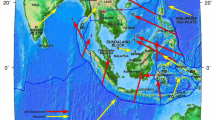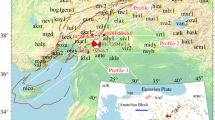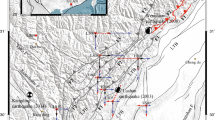Abstract
Relaxation of the coseismic stresses following an earthquake causes postseismic crustal deformation, which can last for days to years. Continuous monitoring of postseismic deformation facilitates the understanding of the mechanism of deformation and postseismic relaxation and viscous rheology. After the October 8, 2005 Kashmir earthquake, global positioning system data for 8 months, starting from October, 2005 have been analyzed from three continuous sites located at Gulmarg, Amritsar, and Jaipur. The average velocity during the observation period at Gulmarg (8.6 cm/year) is significantly higher than the Indian plate velocity exhibiting postseismic crustal deformation. The velocity at Amritsar (5.9 cm/year) and Jaipur (5.1 cm/year) is comparable to the Indian plate velocity. At Gulmarg, the logarithmic function fits well to the north–south component of postseismic transients (~in the coseismic slip direction). The nature of decay in these transients suggests that the deformation is mainly due to an afterslip, and the second possible contribution may be from the viscous relaxation process. This paper presents the characteristics of postseismic transients and possible contributions from various postseismic mechanisms subsequent to the Kashmir earthquake.
Similar content being viewed by others
References
Avouac JP, Ayoub F, Sebastien L, Ozgun K, Helmberger DV (2006) The 2005, Mw 7.6 Kashmir earthquake: sub-pixel correlation of ASTER images and seismic waveforms analysis. Earth Planet Sci Lett 249:514–528
Bendick R, Bilham R, Asif Khan M, Faisal Khan S (2007) Slip on an active wedge thrust from geodetic observations of the 8 October 2005 Kashmir earthquake. Geology 35:267–270
Bettinelli P, Avouac JP, Flouzat M, Jouanne F, Bollinger L, Willis P, Chitrakar GR (2006) Plate motion of India and interseismic strain in the Nepal Himalaya from GPS and DORIS measurements. J Geod 80:567–589
Deng J, Gurnis M, Kanamori H, Hauksson E (1998) Viscoelastic flow in the lower crust after the 1992 Landers earthquake, California. Science 282:1689–1692
Freed AM (2005) Earthquake triggering by static, dynamic, and post-seismic stress transfer. Annu Rev Earth Planet Sci 33:335–367
Jouanne F, Latif M, Majid A, Kausar A, Pécher A, Mugnier JL (2006) Current shortening across the Himalayas: quantification of interseismic deformation in Nepal and first results of postseismic deformation in Pakistan after the 8th October earthquake. Available at: http://lgca.obs.ujf-grenoble.fr/perso/jlmugnie/publications/2006FJICASTPakistan.pdf
King RW, Bock Y (2000) Documentation for the GAMIT GPS analysis software, release 10.0. MIT, Cambridge, MA
Marone CJ, Scholz CH, Bilham R (1991) On the mechanism of earthquake after slip. J Geophys Res 96:8441–8452
Montesi LGJ (2003) Inferring shear zone rheology from the time dependence of postseismic deformation. Available at: http://www.whoi.edu/science/GG/people/lmontesi/POSTERS/DRT2003.pdf
Ohta Y, Irwan M, Ito T, Kimata F, Tabei T, Sagiya T, Sugiyanto D (2006) Afterslip distribution following the 2004 Sumatra–Andaman earthquake in the northern Sumatra Segment based on the near field GPS data. In: Proceedings of the international joint workshop on comprehensive understandings of the 2004 Sumatra earthquake/tsunami and its affections, Syiah Kuala University, Darussalam, Banda Aceh, Indonesia
Panda SK, Saraf AK, Choudhury S, Das JD (2007) Thermal anomaly precedes major earthquake– a case study of 08 October 2005 Kashmir earthquake. In: Proceedings of the Asian seismological conference, symposium on earthquake and tsunami disaster preparedness and mitigation, 2006, Bangkok
Pathier E, Fielding EJ, Wright TJ, Walker R, Parsons BE, Hensley S (2006) Displacement field and slip distribution of the 2005 Kashmir earthquake from SAR imagery. J Geophys Res 33:L20310
Peltzer G, Rosen P, Rogez F, Hudnut K (1996) Postseismic rebound in fault step-over caused by pore fluid flow. Science 273:1202–1204
Piersanti A, Spada G, Sabadini R, Bonafede M (1995) Global post-seismic deformation. Geophys J Int 120:544–566
Rao NP, Kumar P, Kalpana, Tsukuda T, Ramesh DS (2006) The devastating Muzaffarabad earthquake of 8 October 2005: new insights into Himalayan seismicity and tectonics. Gondwana Res 9:365–378
Sabadini R, Vermeersen LLA (1997) Influence of lithospheric and mantle stratification on global post-seismic deformation. Geophys Res Lett 24:2075–2078
Savage JC, Svarc JL (1997) Postseismic deformation associated with the 1992 Mw = 7.3 Landers earthquake, Southern California. J Geophys Res 102:7565–7577
Savage JC, Svarc JL, Yu SB (2005) Postseismic relaxation and transient creep. J Geophys Res 110:B11402
Scholz CH (1998) Earthquakes and friction laws. Nature 391:37–42
Shanker R (1988) Heat-flow of India and discussion on its geological and economic significance. Indian Miner 42:89–110
Shcherbakov R, Turcotte DL, Rundle JB (2004) A generalized Omori’s law for earthquake aftershock decay. Geophys Res Lett 31:L11613
Shen ZK, Jackson DD, Feng Y, Cline M, Kim M, Fang P, Bock Y (1994) Postseismic deformation following the Landers earthquake, California, 28 June 1992. Bull Seismol Soc Am 84:780–791
Wang H, Ge L, Xu C (2007) 3-D coseismic displacement field of the 2005 Kashmir earthquake inferred from satellite radar imagery. Earth Planets Space 59:343–349
Author information
Authors and Affiliations
Corresponding author
Rights and permissions
About this article
Cite this article
Reddy, C.D., Prajapati, S.K. GPS measurements of postseismic deformation due to October 8, 2005 Kashmir earthquake. J Seismol 13, 415–420 (2009). https://doi.org/10.1007/s10950-008-9111-5
Received:
Accepted:
Published:
Issue Date:
DOI: https://doi.org/10.1007/s10950-008-9111-5




